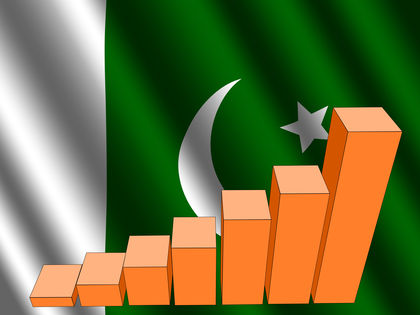Pakistan - Overview of economy

Pakistan is a poor, heavily populated country on which internal political instability, phases of military dictatorship, and inefficient, corrupt governmental rule have taken a toll as much as the costly confrontation with neighboring India ever since partition in 1947. The economy is dominated by services, but agriculture still plays an important role. Pakistan's most important industry is textiles, which alone represents about 60 percent of the country's exports. After growing at an average rate of over 6 percent per year from 1980 to 1991, real gross domestic product (GDP) growth slowed during the 1990s and dropped to 1.3 percent in 1996-97 due to a poor cotton crop and related setbacks in the textile industry. In 1997-98, growth hit 4.3 percent against a governmental target of 6 percent. Real GDP grew only by 3.1 percent in 1998-99 but went up to 4.5 percent during 1999-2000. Pakistan's GDP per capita was US$450 in 1999, which puts it slightly above the South-Asian average of US$440 per capita.
Since the late 1980s, Pakistan has pursued a program of market-oriented economic adjustment, reform, and development. With the support of international financial institutions—mainly the International Monetary Fund (IMF) and bilateral donors—this program has aimed at enhancing macroeconomic stability, promoting the private sector and export-led industrial development, and reversing past neglect of key social sectors such as health, education, and population planning. Specifically, the government has sought to reduce monetary and external imbalances, reduce trade barriers, modernize the financial sector, privatize state-owned industries, and offer specific incentives to attract foreign investment. Unfortunately, the implementation of this program has mostly lagged behind expectations.
Despite the availability of cheap labor, a large domestic market, and access to regional markets, foreign investors have shied away from investing their money in Pakistan because of its widespread corruption, lack of skilled labor, law and order problems (especially in Karachi, the industrial hub), and an outdated infrastructure . Domestic investment has also slowed in recent years. According to official figures, total investment has declined from an average of 17.1 percent of GDP a year between 1984 and 1994 to 7.9 percent between 1994 and 2000. One reason is that manufacturers, who are traditionally served by the domestic banking system (particularly yarn spinners and sugar refiners), have often failed to honor their debts, contributing to a banking crisis.
Underlying most of the economic problems faced by Pakistan is the "crisis of governance," as the World Bank calls it. This phrase refers to the poor performance of the public institutions in terms of accountability, efficient management, corruption, and tax collection. Among these, corruption is one of the most pressing problems. Transparency International, an international non-governmental organization monitoring governments, ranked Pakistan 2nd, 5th, and 11th, in its annual reports on the most corrupt countries in the world between 1996 and 1998. Corruption hurts the economy by raising transaction costs. Even if these payoffs are considered part of the cost of doing business, there is an economic loss as these payments are neither available for expansion and improvement in the quality of public services, nor for private sector investment. A 1994 survey conducted by the World Bank among 200 business firms in Pakistan revealed that a significant amount of time and money was wasted in numerous unpredictable interactions with petty and higher-level bureaucrats seeking bribes. Entrepreneurs reported spending about 12 percent of their time dealing with tax and regulatory requirements. Also, corruption depresses economic growth by lowering public investment. Only a part of the amount appearing in budget documents as expenditure on public projects may actually get spent on these projects; the rest is siphoned off by government functionaries and contractors. One study estimated that the value for money obtained in government construction of school buildings may be only 50 to 60 percent.
Another major problem is Pakistan's huge external debt and its continued dependence on financial aid. Foreign loans and grants provide approximately 25 percent of government revenue, and debt service obligations total nearly 50 percent of government expenditure, which means that as much as half of all government expenditures are used to repay loans. Defense and debt service together absorb more than two-thirds of total federal expenditure, or almost all revenues from federal taxes. Improving tax collection in the medium-to long-term is crucial if Pakistan is to maintain repayments on its combined foreign and domestic debt of about US$62 billion, almost equivalent to Pakistan's annual GDP. It is estimated that the country needs at least US$21 billion of aid up to 2004 just for debt repayment, a large figure for a nation with annual exports of less than US$9 billion and very little foreign exchange reserves . In the case of the provinces, the bulk of expenditure is taken up by establishment costs (civil servants' salaries, benefits, and pensions), interest payments, and subsidies . The government under General Pervez Musharraf, which overthrew the government under Nawaz Sharif in 1999, faced US$32 billion in external debt. General Musharraf's ambitious economic agenda includes measures to widen the tax net, privatize public sector assets, and improve its balance of trade position. Commitment to these reforms, however, has to withstand strong opposition from interest groups such as employees of state-owned corporations, private traders, landlords, and government bureaucrats. It is unclear how the U.S. war against the Taliban regime in neighboring Afghanistan, begun in 2001, will impact Pakistan's economy.
it will pleasure for me if you help me.